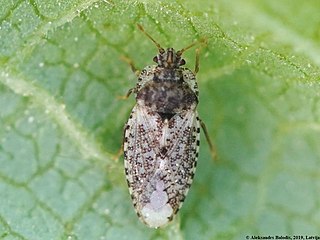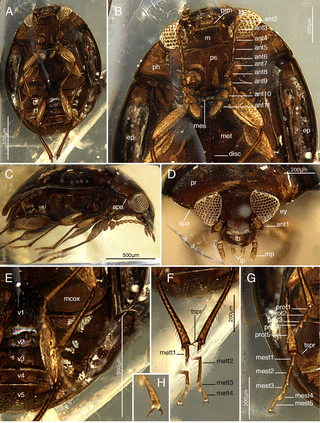
Scydmaeninae are a subfamily of small beetles, commonly called ant-like stone beetles or scydmaenines. These beetles occur worldwide, and the subfamily includes some 4,500 species in about 80 genera. Established as a family, they were reduced in status to a subfamily of Staphylinidae in 2009

Piesmatidae is a small family of true bugs, commonly called ash-grey leaf bugs. The Piesmatidae are distributed mostly in the temperate Northern Hemisphere, with some occurring in Africa, Australia and South America. A common species found throughout the Americas is Piesma cinereum.

The Mordellidae are a family of beetles commonly known as tumbling flower beetles for the typical irregular movements they make when escaping predators, or as pintail beetles due to their abdominal tip which aids them in performing these tumbling movements. Worldwide, there are about 1500 species.

Smicripidae is a family of beetles, in the superfamily Cucujoidea. The common name for this family is palmetto beetles. The family only has one extant genus, Smicrips, with six extant species native to tropical and subtropical regions of the Americas and extinct species from the Eocene of Europe and one extinct genus, Mesosmicrips, known from the mid Cretaceous aged Burmese amber. Smicrips larvae are usually found amongst decaying vegetation, while adults are typically found on inflorescences, especially those of Arecaceae (palms), although associations with flowers of Fabaceae (legumes), Passifloraceae, Bombacaceae and Cactaceae (cactus) have also been recorded. Their diet is unknown.
Manobiomorpha is an extinct genus of flea beetles described from the late Eocene Rovno amber of Ukraine. It was named by Konstantin Nadein and Evgeny Perkovsky in 2010, and the type species is Manobiomorpha eocenica.
Psyllototus is an extinct genus of flea beetles described from the late Eocene Rovno amber of Ukraine, and from the Baltic amber of Russia and Denmark. It was named by Konstantin Nadein and Evgeny Perkovsky in 2010, and the type species is Psyllototus progenitor. In 2016, a newly described extant flea beetle genus from Bolivia, Chanealtica, was found to be most similar to Psyllototus, based on the characters available for observation.
Paleophaedon is an extinct genus of chrysomeline leaf beetle described from the late Eocene Rovno amber of Ukraine. It was named by Konstantin Nadein and Evgeny Perkovsky in 2010, and the type species is Paleophaedon minutus.
Glipostena is a genus of beetles in the family Mordellidae, containing the following species:

Mordellinae is a subfamily of beetles commonly known as tumbling flower beetles for the typical irregular movements they make when escaping predators, or as pintail beetles due to their abdominal tip which aids them in performing these tumbling movements.
Glipostena congoana is a species of beetle in the genus Glipostena. It was discovered in 1952.
Glipostena sergeli is a species of beetle in the genus Glipostena. It was discovered in 1942.
Glipostena dimorpha is a species of beetle in the genus Glipostena. It was discovered in 1999.
Glipostena hogsbacki is a species of beetle in the genus Glipostena. It was discovered in 1999. It is known from Sulawesi.
Glipostena medleri is a species of beetle in the genus Glipostena. It was discovered in 1999.
Glipostena nigricans is a species of beetle in the genus Glipostena. It was discovered in 2000.
Glipostena nemoralis is a species of beetle in the genus Glipostena. It was discovered in 1962.
Glipostena pelecotomoidea is a species of beetle in the genus Glipostena. It was discovered in 1911.

Rivne amber, occasionally called Ukrainian amber, is amber found in the Rivne Oblast and surrounding regions of Ukraine and Belarus. The amber is dated between Late Eocene and Early Oligocene, and suggested to be contemporaneous to Baltic amber. Major exploration and mining of the amber did not start until the 1990s.

Nylanderia pygmaea is an extinct species of formicid in the ant subfamily Formicinae known from fossils found in the Prussian Formation of the Baltic region.

Cyclaxyridae are a family of beetles in the superfamily Cucujoidea. The only living genus is Cyclaxyra, with two species endemic to New Zealand. Other species have been named from fossils. They are also known as sooty mould beetles due to the association of Cyclaxyra with sooty mould. The extant species are mycophagous, feeding on spores, conidia, and hyphae.






